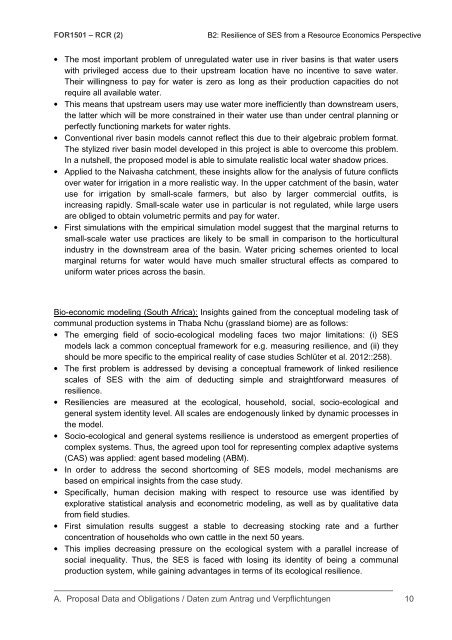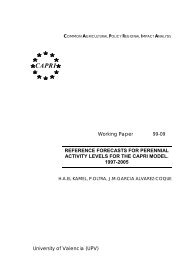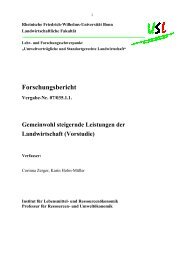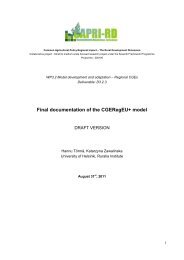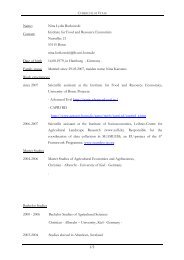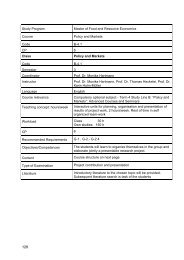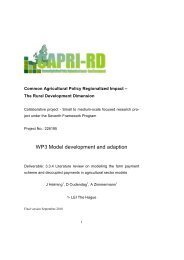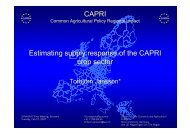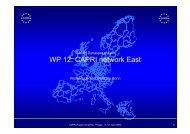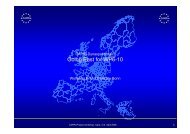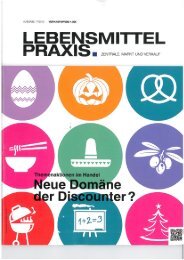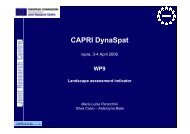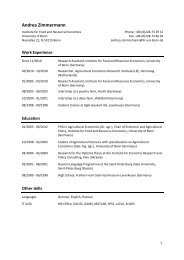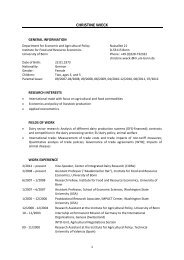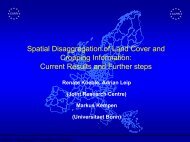Research proposal of sub-project B2 for second phase - Institut für ...
Research proposal of sub-project B2 for second phase - Institut für ...
Research proposal of sub-project B2 for second phase - Institut für ...
Create successful ePaper yourself
Turn your PDF publications into a flip-book with our unique Google optimized e-Paper software.
FOR1501 – RCR (2)<br />
<strong>B2</strong>: Resilience <strong>of</strong> SES from a Resource Economics Perspective<br />
• The most important problem <strong>of</strong> unregulated water use in river basins is that water users<br />
with privileged access due to their upstream location have no incentive to save water.<br />
Their willingness to pay <strong>for</strong> water is zero as long as their production capacities do not<br />
require all available water.<br />
• This means that upstream users may use water more inefficiently than downstream users,<br />
the latter which will be more constrained in their water use than under central planning or<br />
perfectly functioning markets <strong>for</strong> water rights.<br />
• Conventional river basin models cannot reflect this due to their algebraic problem <strong>for</strong>mat.<br />
The stylized river basin model developed in this <strong>project</strong> is able to overcome this problem.<br />
In a nutshell, the proposed model is able to simulate realistic local water shadow prices.<br />
• Applied to the Naivasha catchment, these insights allow <strong>for</strong> the analysis <strong>of</strong> future conflicts<br />
over water <strong>for</strong> irrigation in a more realistic way. In the upper catchment <strong>of</strong> the basin, water<br />
use <strong>for</strong> irrigation by small-scale farmers, but also by larger commercial outfits, is<br />
increasing rapidly. Small-scale water use in particular is not regulated, while large users<br />
are obliged to obtain volumetric permits and pay <strong>for</strong> water.<br />
• First simulations with the empirical simulation model suggest that the marginal returns to<br />
small-scale water use practices are likely to be small in comparison to the horticultural<br />
industry in the downstream area <strong>of</strong> the basin. Water pricing schemes oriented to local<br />
marginal returns <strong>for</strong> water would have much smaller structural effects as compared to<br />
uni<strong>for</strong>m water prices across the basin.<br />
Bio-economic modeling (South Africa): Insights gained from the conceptual modeling task <strong>of</strong><br />
communal production systems in Thaba Nchu (grassland biome) are as follows:<br />
• The emerging field <strong>of</strong> socio-ecological modeling faces two major limitations: (i) SES<br />
models lack a common conceptual framework <strong>for</strong> e.g. measuring resilience, and (ii) they<br />
should be more specific to the empirical reality <strong>of</strong> case studies Schlüter et al. 2012::258).<br />
• The first problem is addressed by devising a conceptual framework <strong>of</strong> linked resilience<br />
scales <strong>of</strong> SES with the aim <strong>of</strong> deducting simple and straight<strong>for</strong>ward measures <strong>of</strong><br />
resilience.<br />
• Resiliencies are measured at the ecological, household, social, socio-ecological and<br />
general system identity level. All scales are endogenously linked by dynamic processes in<br />
the model.<br />
• Socio-ecological and general systems resilience is understood as emergent properties <strong>of</strong><br />
complex systems. Thus, the agreed upon tool <strong>for</strong> representing complex adaptive systems<br />
(CAS) was applied: agent based modeling (ABM).<br />
• In order to address the <strong>second</strong> shortcoming <strong>of</strong> SES models, model mechanisms are<br />
based on empirical insights from the case study.<br />
• Specifically, human decision making with respect to resource use was identified by<br />
explorative statistical analysis and econometric modeling, as well as by qualitative data<br />
from field studies.<br />
• First simulation results suggest a stable to decreasing stocking rate and a further<br />
concentration <strong>of</strong> households who own cattle in the next 50 years.<br />
• This implies decreasing pressure on the ecological system with a parallel increase <strong>of</strong><br />
social inequality. Thus, the SES is faced with losing its identity <strong>of</strong> being a communal<br />
production system, while gaining advantages in terms <strong>of</strong> its ecological resilience.<br />
A. Proposal Data and Obligations / Daten zum Antrag und Verpflichtungen 10


